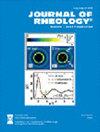应力控制流变法中仪器惯量对振荡流起始的影响
IF 3.2
2区 工程技术
Q2 MECHANICS
引用次数: 0
摘要
在最近的一篇论文[Hassager, J. Rheol. 64, 545-550(2020)]中,Hassager基于一般线性粘弹性理论对应力控制振荡流的启动进行了分析。该分析为探索建立应力控制振荡流变法固有的稳定应变偏移提供了理论基础。然而,该分析忽略了仪器惯性对建立稳定周期响应的影响。在框架中包含惯性项是很重要的,因为它(i)引起了惯性弹性环,(ii)在响应的周期部分引入了额外的相移。在此,我们修改表达式以包含适当的惯性贡献,并证明附加项的存在可以对获得稳态周期响应所需的时间尺度产生实质性影响。然后将分析应用于蠕虫状胶束的水溶液。本文章由计算机程序翻译,如有差异,请以英文原文为准。
The effect of instrument inertia on the initiation of oscillatory flow in stress controlled rheometry
In a recent paper [Hassager, J. Rheol. 64, 545–550 (2020)], Hassager performed an analysis of the start up of stress-controlled oscillatory flow based on the general theory of linear viscoelasticity. The analysis provided a theoretical basis for exploring the establishment of a steady strain offset that is inherent to stress controlled oscillatory rheometric protocols. However, the analysis neglected the impact of instrument inertia on the establishment of the steady periodic response. The inclusion of the inertia term in the framework is important since it (i) gives rise to inertio-elastic ringing and (ii) introduces an additional phase shift in the periodic part of the response. Herein, we modify the expressions to include an appropriate inertial contribution and demonstrate that the presence of the additional terms can have a substantial impact on the time scale required to attain the steady state periodic response. The analysis is then applied to an aqueous solution of wormlike micelles.
求助全文
通过发布文献求助,成功后即可免费获取论文全文。
去求助
来源期刊

Journal of Rheology
物理-力学
CiteScore
6.60
自引率
12.10%
发文量
100
审稿时长
1 months
期刊介绍:
The Journal of Rheology, formerly the Transactions of The Society of Rheology, is published six times per year by The Society of Rheology, a member society of the American Institute of Physics, through AIP Publishing. It provides in-depth interdisciplinary coverage of theoretical and experimental issues drawn from industry and academia. The Journal of Rheology is published for professionals and students in chemistry, physics, engineering, material science, and mathematics.
 求助内容:
求助内容: 应助结果提醒方式:
应助结果提醒方式:


